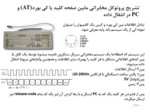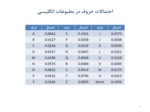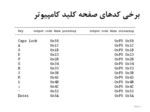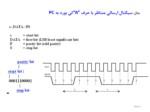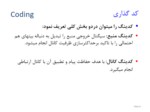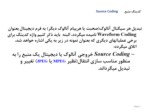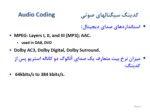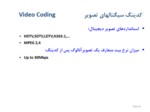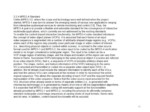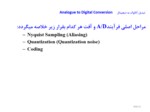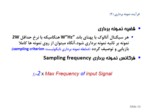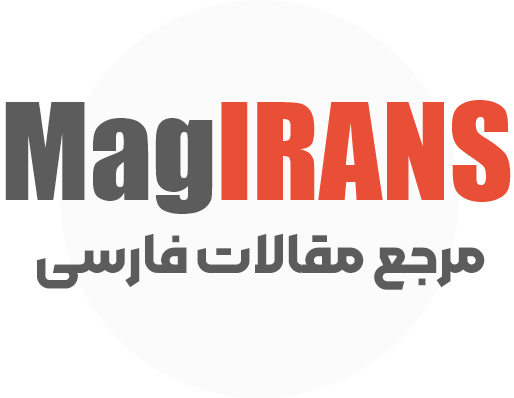بخشی از پاورپوینت
--- پاورپوینت شامل تصاویر میباشد ----
اسلاید 1 :
تبادل اطلاعات بین کی بورد و کیس یک کامپیوتر را میتوان
نمونه ائی از یک سیستم باند پایه معرفی نمود.
این سیستم که اصطلاحا یک سیستم مخابراتی سریال سنکرون نامیده میشود.توسط یک کابل 5 پین کدهای اطلاعاتی متناظر با هر کلید را بهمراه سایر اطلاعات و همچنین ولتاژهای مربوط انتقال داده میشوند:
پین2: ارسال اطلاعات
پین1: پالس ساعت (سیگنالی با فرکانس 10-20kHz)
پین5:ولتاژ 5V
پین4: زمین
پس از فشردن هر کلید یک کد به PC ارسال و با رها کردن آن نیز یک کد بنام release-code نیز ارسال میگردد.
اسلاید 2 :
- کدینگ را میتوان دردو بخش کلی تعریف نمود:
- کدینگ منبع: سیگنال خروجی منبع را تبدیل به دنباله بیتهای هم احتمالی را با تاکید برحداکثرسازی ظرفیت کانال انجام میشود.
- کدینگ کانال: با هدف حفاظت پیام و تطبیق آن با کانال ارتباطی انجام میگیرد.
اسلاید 3 :
- تبدیل آنالوگ به دیجیتال که عموما با نام
“PCM: Pulse Code Modulation”
نیز شناخته میشود از دو مرحله اساسی تشکیل میشود:
–نمونه برداری یکنواخت(Regular) سیگنال ورودی
–تبدیل نمونه ها به اعداد و شماره های گسسته
دقت هر مبدل A/D به تعداد بیتهای خروجی آن وابسته است، در زیر مقدار معمول بیت خروجی برخی انکدرهای متداول ارایه شده است:
- Speech 8 bit
- Music HiFi 16/18, even 24 bit
- [Video 8 bit x 3 colours to give 24 bit]
–
اسلاید 4 :
- استانداردهای صدای دیجیتال:
- MPEG: Layers I, II, and III (MP3); AAC.
- used in DAB, DVD
- Dolby AC3, Dolby Digital, Dolby Surround.
- میزان نرخ بیت متعارف یک صدای آنالوگ دو کاناله استریو پس از کدینگ:
- 64kbits/s to 384 kbits/s.
اسلاید 5 :
- استانداردهای تصویر دیجیتال:
- HDTV,SDTV,LDTV,H263.1,…
- MPEG 2,4
- میزان نرخ بیت متعارف یک تصویرآنالوگ پس از کدینگ:
- Up to 30Mbps
اسلاید 6 :
2.2.4 MPEG-4 Standard
Unlike MPEG-1/2, where the scope and technology were well defined when the project
started, MPEG-4 was born to answer the emerging needs of various new applications ranging
from interactive audiovisual services to remote monitoring and control [13]. Thus, the
MPEG-4 goal is to provide a flexible and extensible standard for the convergence of interactive
multimedia applications, which currently are not addressed by the existing standards.
To enable the content-based interactive functionality, the MPEG-4 video standard introduces
the concept of video object planes (VOPs). It is assumed that each frame of an input
video sequence is segmented into a number of arbitrarily shaped image regions (e.g., VOPs),
where each of the regions may possibly cover particular image or video content of interest
(i.e., describing physical objects or content within scenes). In contrast to the video source
format used for MPEG-1 and MPEG-2, the video input to be coded by the MPEG-4 verification
model is no longer considered a rectangular region. The input to be coded can be a
VOP image region of arbitrary shape, and the shape and location of the region can vary from
frame to frame. Successive VOPs belonging to the same physical object in a scene are referred
to as video objects (VOs), that is, a sequence of VOPs of possibly arbitrary shape and
position. The shape, motion, and texture information of the VOPs belonging to the same
VO is encoded and transmitted or coded into a separate video object layer (VOL). In
addition, the bit stream must include the relevant information to identify each of the VOLs,
and how the various VOLs are composed at the receiver in order to reconstruct the entire
original sequence. This allows the separate decoding of each VOP and the required flexible
manipulation of the video sequence. Notice that the video source input assumed for the
VOL structure either already exists in terms of separate entities (i.e., is generated with
chroma-key technology) or is generated by means of on-line or off-line segmentation algorithms.
It is expected that MPEG-4 video coding will eventually support all the functionalities
already provided by MPEG-1 and MPEG-2, including the provision to efficiently compress
standard rectangular sized image sequences at varying levels of input formats, frame rates
and bit rates. In addition, content-based functionality will be assisted.
اسلاید 7 :
مراحل اصلی فرآیندA/D و آفت هر کدام بقرار زیر خلاصه میگردد:
–Nyquist Sampling (Aliasing)
–Quantization (Quantization noise)
–Coding
اسلاید 8 :
- نمونه برداری Sampling
- تبدیل یک سیگنال از حالت ”پیوسته زمان“ به گسسته زمان
- ضرورت نمونه برداری :
- در صورتی که پیام یک سیگنال آنالوگ باشد لازم است قبل از مدولاسیون دیجیتال یا PCM آنرا بسبب اینکه از بینهایت دامنه شمارش ناپذیر تشکیل شده به تعداد شمارش پذیری نمونه برداری کنیم.
- بهنگام دریافت یک سیگنال دیجیتال نیز
بسبب عملکرد کانالهای انتقال همیشه با یک
سیگنال آنالوگ مواجهیم، لذا لازم است
قبل از ”دمدولاسیون“ آنرا نمونه برداری
کنیم.
اسلاید 9 :
- قضیه نمونه برداری
- هر سیگنال آنالوگ با پهنای باند W”Hz” هنگامیکه با نرخ حداقل 2W نمونه بر ثانیه نمونه برداری شود،آنگاه میتوان از روی نمونه ها کاملا بازیابی و توصیف گردد (ضابطه نمونه برداری نایکوئیستsampling criterion ).
- فرکانس نمونه برداری Sampling frequency
اسلاید 10 :
سیگنال نمونه برداری شده در زمان و فرکانس(1)
- حالت اول : نمونه برداری با فرکانس نمونه برداری کمتر از حد نایکوئیست


